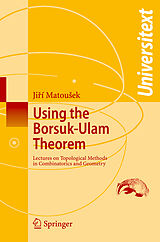Using the Borsuk-Ulam Theorem
Einband:
Kartonierter Einband
EAN:
9783540003625
Untertitel:
Lectures on Topological Methods in Combinatorics and Geometry
Autor:
Jiri Matousek
Herausgeber:
Springer Berlin Heidelberg
Auflage:
2003
Anzahl Seiten:
228
Erscheinungsdatum:
17.04.2003
ISBN:
3540003622
A number of important results in combinatorics, discrete geometry, and theoretical computer science have been proved using algebraic topology. While the results are quite famous, their proofs are not so widely understood. They are scattered in research papers or outlined in surveys, and they often use topological notions not commonly known among combinatorialists or computer scientists. This book is the first textbook treatment of a significant part of such results. It focuses on so-called equivariant methods, based on the Borsuk-Ulam theorem and its generalizations. The topological tools are intentionally kept on a very elementary level (for example, homology theory and homotopy groups are completely avoided). No prior knowledge of algebraic topology is assumed, only a background in undergraduate mathematics, and the required topological notions and results are gradually explained. At the same time, many substantial combinatorial results are covered, sometimes with some of the most important results, such as Kneser's conjecture, showing them from various points of view. The history of the presented material, references, related results, and more advanced methods are surveyed in separate subsections. The text is accompanied by numerous exercises, of varying difficulty. Many of the exercises actually outline additional results that did not fit in the main text. The book is richly illustrated, and it has a detailed index and an extensive bibliography. This text started with a one-semester graduate course the author taught in fall 1993 in Prague. The transcripts of the lectures by the participants served as a basis of the first version. Some years later, a course partially based on that text was taught by Günter M. Ziegler in Berlin. The book is based on a thoroughly rewritten version prepared during a pre-doctoral course the author taught at the ETH Zurich in fall 2001. Most of the material was covered in the course:Chapter 1 was assigned as an introductory reading text, and the other chapters were presented in approximately 30 hours of teaching (by 45 minutes), with some omissions throughout and with only a sketchy presentation of the last chapter.
The only textbook on these topics The author is an outstanding researcher Includes supplementary material: sn.pub/extras
Klappentext
"The "Kneser conjecture" -- posed by Martin Kneser in 1955 in the Jahresbericht der DMV -- is an innocent-looking problem about partitioning the k-subsets of an n-set into intersecting subfamilies. Its striking solution by L. Lovász featured an unexpected use of the Borsuk-Ulam theorem, that is, of a genuinely topological result about continuous antipodal maps of spheres. Matousek's lively little textbook now shows that Lovász' insight as well as beautiful work of many others (such as Vrecica and Zivaljevic, and Sarkaria) have opened up an exciting area of mathematics that connects combinatorics, graph theory, algebraic topology and discrete geometry. What seemed like an ingenious trick in 1978 now presents itself as an instance of the "test set paradigm": to construct configuration spaces for combinatorial problems such that coloring, incidence or transversal problems may be translated into the (non-)existence of suitable equivariant maps. The vivid account of this area and its ramifications by Matousek is an exciting, a coherent account of this area of topological combinatorics. It features a collection of mathematical gems written with a broad view of the subject and still with loving care for details. Recommended reading! []" Günter M.Ziegler (Berlin)
Zbl. MATH Volume 1060 Productions-no.: 05001
Inhalt
Preliminaries.- 1 Simplicial Complexes: 1.1 Topological spaces; 1.2 Homotopy equivalence and homotopy; 1.3 Geometric simplicial complexes; 1.4 Triangulations; 1.5 Abstract simplicial complexes; 1.6 Dimension of geometric realizations; 1.7 Simplicial complexes and posets.- 2 The Borsuk-Ulam Theorem: 2.1 The Borsuk-Ulam theorem in various guises; 2.2 A geometric proof; 2.3 A discrete version: Tucker's lemma; 2.4 Another proof of Tucker's lemma.- 3 Direct Applications of Borsuk--Ulam: 3.1 The ham sandwich theorem; 3.2 On multicolored partitions and necklaces; 3.3 Kneser's conjecture; 3.4 More general Kneser graphs: Dolnikov's theorem; 3.5 Gale's lemma and Schrijver's theorem.- 4 A Topological Interlude: 4.1 Quotient spaces; 4.2 Joins (and products); 4.3 k-connectedness; 4.4 Recipes for showing k-connectedness; 4.5 Cell complexes.- 5 Z_2-Maps and Nonembeddability: 5.1 Nonembeddability theorems: An introduction; 5.2 Z_2-spaces and Z_2-maps; 5.3 The Z_2-index; 5.4 Deleted products good ...; 5.5 ... deleted joins better; 5.6 Bier spheres and the Van Kampen-Flores theorem; 5.7 Sarkaria's inequality; 5.8 Nonembeddability and Kneser colorings; 5.9 A general lower bound for the chromatic number.- 6 Multiple Points of Coincidence: 6.1 G-spaces; 6.2 E_nG spaces and the G-index; 6.3 Deleted joins and deleted products; 6.4 Necklace for many thieves; 6.5 The topological Tverberg theorem; 6.6 Many Tverberg partitions; 6.7 Z_p-index, Kneser colorings, and p-fold points; 6.8 The colored Tverberg theorem.- A Quick Summary.- Hints to Selected Exercises.- Bibliography.- Index.

Leider konnten wir für diesen Artikel keine Preise ermitteln ...
billigbuch.ch sucht jetzt für Sie die besten Angebote ...
Die aktuellen Verkaufspreise von 6 Onlineshops werden in Realtime abgefragt.
Sie können das gewünschte Produkt anschliessend direkt beim Anbieter Ihrer Wahl bestellen.
Loading...
Die aktuellen Verkaufspreise von 6 Onlineshops werden in Realtime abgefragt.
Sie können das gewünschte Produkt anschliessend direkt beim Anbieter Ihrer Wahl bestellen.
| # | Onlineshop | Preis CHF | Versand CHF | Total CHF | ||
|---|---|---|---|---|---|---|
| 1 | Seller | 0.00 | 0.00 | 0.00 |
